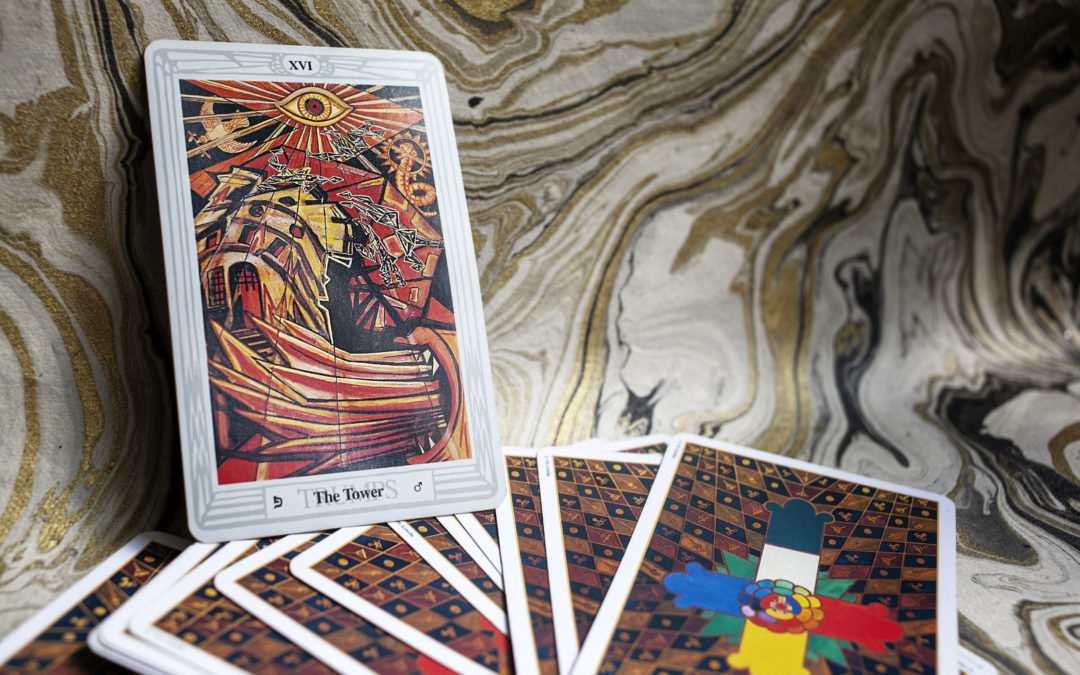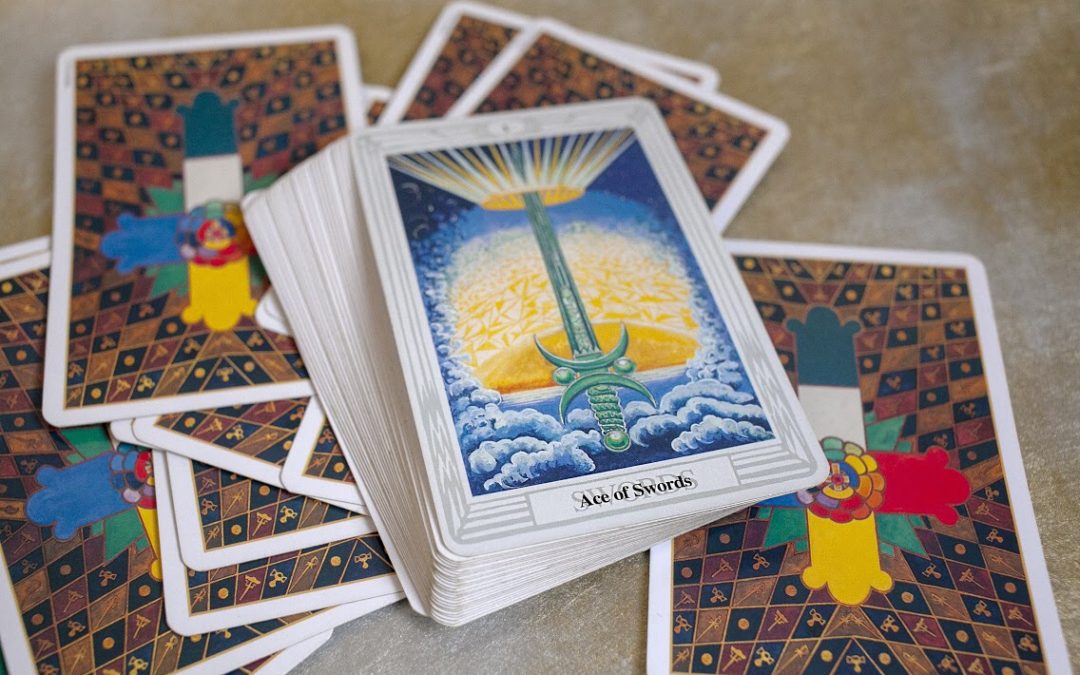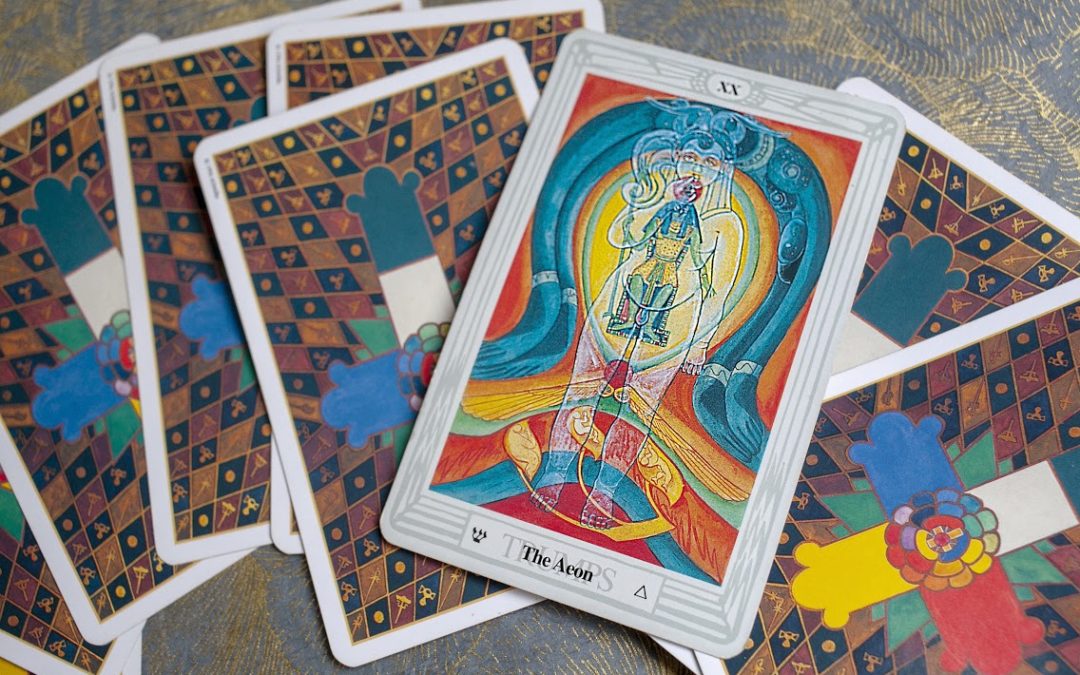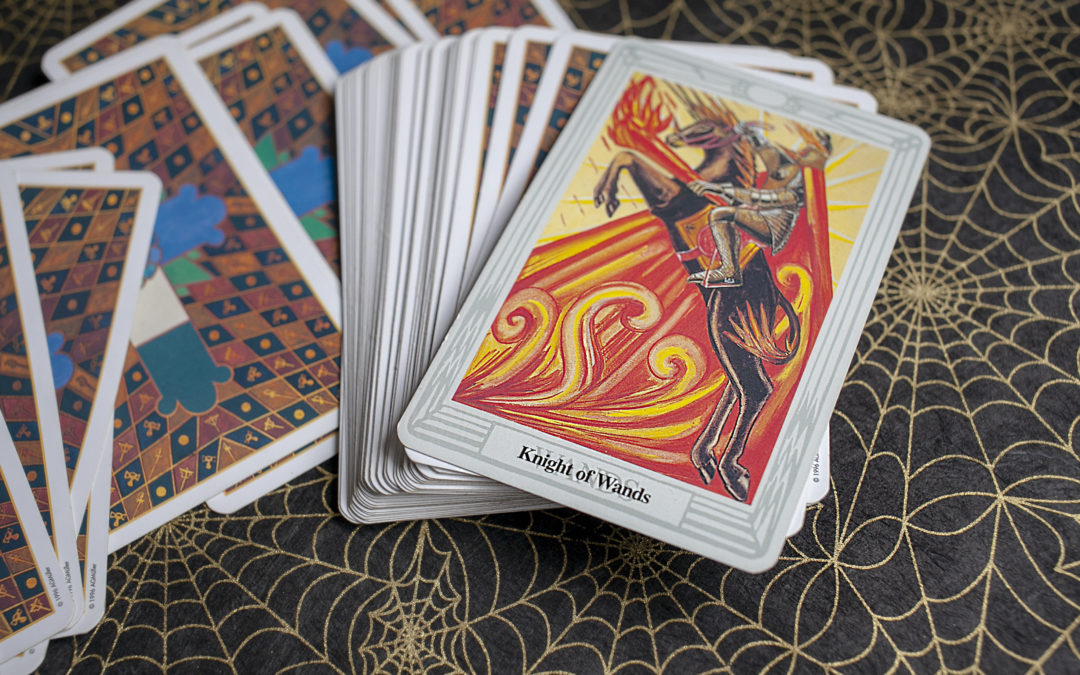
by Kosmic Tonic | Aug 8, 2019 | Tarot
Six months ago, close to the previous eclipses along the Cancer-Capricorn axis, Jasmine and I wedged our way through a shaft of the Great Pyramid at Giza. Tourists wilted on all sides from over-exertion or claustrophobia or heat stroke — it must have been a hundred degrees inside. Jasmine and I had experienced a few underworld journeys by this point in the trip, including a low-key syncopic seizure on my part that necessitated a trip to an airport hospital. By the time we squeezed our way back to the sunlight, salt crusting our foreheads from the sweat, hair dishevelled, eyes blinking out dust, we referred to the pyramid, wryly, as our birth canal.
The first card Jasmine and I drew, when we launched an earlier iteration of our website, was the Tower card. In some ways, it’s haunted us: that terrible tube-mouth, flashing out shards of fire, the tower itself cubist and fragmented, as if viewed from the reflection of a broken mirror. The eye of Horus, the anonymous angular shadows — inhuman in form, but like origami window jumpers. The entire card burning and bloodshot and red.
Whose heart doesn’t sink when they pull this card?
The astrological correspondence for this card is planetary Mars. Mars as fire, initiation, battlefield, destruction. In the sequence of the major arcana, the Tower follows the Devil, who is represented by the sign of Capricorn. Capricorn brings us stability, ninety degree angles (of walls and the roofs over our heads), systems, authority. The Tower card portrays the old system burning — Mars undiscriminating in its fire, with a drive only to level.
The author at Esoteric Meanings describes the Tower as the “glyph for the process of PURIFICATION THROUGH FIRE.” And that’s another way of understanding this Mars. The Hebrew letter assigned to this card is פ (pe), or mouth. But the mouth does not devour from hunger or avarice. Nor is the violence inspired from cruelty — no more than a natural forest fire or earthquake. A tide of destruction follows the tide of reaping as surely as winter follows harvest.
Sometimes, the structures we have leaned on need replacing, and the only way to do so is light a match. It’s uncomfortable. It might be wildly painful, at times. But it’s a re-birthing, too. This card turned out to be a fair representation of our journey so far, culminating (a year after we pulled it) with Jasmine’s study of the Qabalah, and her interpretation of this card as an internal alchemical process — indeed an alchemy of the soul. (For more on this, check out Jasmine’s recent talk at the Fresh Voices in Astrology Summit.)
Religions around the world include a form of ritual purification, whether to initiate the believer into the religion (such as a Christian baptism), or smudging to clear a space, or banishing, or carefully washing the body before prayer. We might think of Mars this way, as the knife that removes the tumour, or a flame that sterilizes the needle (or our etheric bodies / inner worlds.) In the Book of Thoth, Aleister Crowley compares this card to Shiva the Destroyer, who dances upon the bodies of his devotees. Crowley explains:
Briefly, the doctrine is that the ultimate reality (which is Perfection) is Nothingness. Hence all manifestations, however glorious, however delightful, are stains. To obtain perfection, all existing things must be annihilated.
Sounds extreme, but sometimes complete severance from the past (especially toxic habits, people, influences) is exactly what is required.
The next card in the sequence is the Star, which signals the return of hope, light, wonder and awe. Crowley concludes his chapter on the Star with words from Nuit, the goddess featured on the card, pouring water between two cups: I give unimaginable joys on earth: certainty, not faith, while in life, upon death; peace unutterable, rest, ecstasy; nor do I demand aught in sacrifice…Sing the rapturous love-song unto me! Burn to me perfumes! Wear to me jewels! Drink to me, for I love you! I love you! I am the blue-lidded daughter of Sunset; I am the naked brilliance of the voluptuous night-sky.
After all, a tide of sewing follows the tide of destruction once more.

by Kosmic Tonic | Mar 19, 2019 | Tarot
This card is attributed to the letter Nun, which means fish; the symbol of life beneath the waters; life traveling through the waters.
So begins Crowley’s interpretation of the Death card. Ever a contrarian, he opens with an emphasis on life.
This card is represented by the sign of Scorpio, as indicated by the scorpion on the bottom right. Though the planet Saturn has no relation to Scorpio, his symbolism is prominent in this card: the skeleton figure, every bit the Grim Reaper, and his scythe. Saturn may be the lord of death among astrologers, but he also represents structure and form. Death has a way of dissolving, or defying both.
Crowley’s Death figure is unlike other decks’ representations in that he wears the helmet of Osiris. Osiris, Lord of the Underworld, brother-husband to Isis, unceremoniously dismembered by their younger brother, Set.
In this card, he dances a gruesome jig, his legs forming the sigil of planetary Saturn (♄). In the Middle Ages, a fixation on death (possibly due to the plague) inspired representations of the “dance of death,” or danse macabre, in literary and visual art: a parade of live and dead figures wiggling toward their doom. The figures were arranged by rank: from Pope and Emperor to child or clerk, all cavorting to the same loading dock, as it were. These images captured that certainty and impartiality of death; in so much Saturn represents hierarchy and authority figures, Death further suggests his undoing.
Crowley’s Death card also indicates the three “levels” of Scorpio:
- the scorpion
- the fish or snake (painted in almost the same brush stroke)
- the eagle (featured in the top left, above Osiris’ head)
I encountered this archetype of Scorpio-as-Eagle early in my studies of astrology, and it always threw me for a loop. However, the archetypes are explained in the astronomy: the constellation Scorpius sits beside Ophiuchus, “the serpent bearer,” and Aquila the eagle.
The scorpion archetype represents the primal, bottom-feeding, even self-destructive urges of this sign. The earthbound Mars energy that thinks with his… root chakra. An (unsubstantiated) myth of scorpions in nature suggests that they’ll sting themselves in the head if surrounded by a ring of fire. The Scorpion “level” of Scorpio may not sound very flattering, but it’s necessary. We would be nowhere with our basest urges to eat, protect ourselves, procreate.
The fish or snake represents the regenerative quality of Scorpio. The fish was understood as a symbol of rebirth in Egyptian mythology, especially the tilapia, who carry eggs in their mouths until they hatch. Then of course there’s ichthys, the fish symbol for Christ. Snakes too embody the idea of rebirth and transformation: after all, they shed, and re-grow, their own skin. And as Esoteric Meanings eloquently words it: life and death are two curves of the same serpent.
The final “tier” of Scorpio is the least intuitive: the Eagle. Deborah Houlding writes compellingly of this archetype: If, as the Egyptians thought, scorpions represent initiation into the sacred mysteries, we can consider the sign’s other related creature, the eagle, as a higher expression of Scorpio power…Transcendence from the crawling scorpion to the soaring eagle, still predatory, still conveying the essence of patience and penetration, but capable of flight and height, brings together the theme of destruction and renewal as a story of evolution.
From the earthly urges of the scorpion, through the regeneration of the fish / snake, to transcendence, the soaring eagle, and access to the mysteries: the sign Scorpio and the card Death contain all three. And it may not present as a gradation, or an evolution: we can engage on all three planes at once. And we do.
When this card turns up, consider the forms or structures or habits you are releasing. Know that transformation may involve a journey into the dark. It may involve detachment and letting go of what we perceive to be important, but an Eagle (or phoenix) awaits you on the other side. Only through certain sewer journeys do we find constructive change, necessary shedding, and higher knowing. Maybe that’s why it’s hard to freak out a Scorpio: they have the impenetrability of experience about them. They’ve been there. Shed that. And come out (relatively) unscathed.
A Zen proverb captures this card rather bluntly: Let go, or be dragged.
References:
Esoteric Meanings
The Book of Thoth
Deborah Houlding

by Kosmic Tonic | Mar 16, 2019 | Tarot
The Ace of Swords is the root of the Air element: the purest essence of Air, which we associate with the mind, words, and law. For what is law but language? Indeed, θέλημα, or “THELEMA” is inscribed on the blade: the Greek word for “will,” or “the word of the law” for Crowley. Immediately, I think of the Sword of Justice in the Adjustment (or Justice) card. And the Queen of Swords, a head dangling from her fist. That ruthless, stone-eyed face the law can have: “blind,” in theory, for better or worse.
Some of the symbolism on this card is difficult to grasp if you’re not familiar with the Kabbalah. It is said that Air is formed from the union of Fire and Water: and so we see the sun rising from the lake or ocean, the clouds sudsing around it. Maybe you don’t need to know the Kabbalah to understand this one after all. What happens to water when we boil it?
The crown is lit by 22 rays: perhaps representing the 22 major arcana, or the 22 pathways of the Tree of Life. All of the aces correspond to Kether in the Tree: the topmost sphere, considered so sublime it’s completely incomprehensible (to us.)
A snake coils six times around the hilt, which is said to be of copper, Venus’ metal. There seems to be a symmetry implicit in that: Venus countering the violence of the sword. The crescent moons balancing the Sun on the water. We say a strong mind is “level-headed,” another word for balanced.
If you’ve dabbled in the Tarot, you’ll have noticed that many cards in the Sword suit have more negative or challenging connotations. In this deck, the Ten of Swords is captioned “Ruin,” the Five of Swords, “Defeat,” the Nine of Swords, “Cruelty,” and so on. It makes sense in a way. We only experience difficulty with our mind. As told in the old adages: “ignorance is bliss” (and so what is the opposite), or “curiosity killed the cat.” Once we turn our brains on and really examine the story we’ve found ourselves in, we get into trouble. A blue pill / red pill conundrum.
Red Pill: “a life of harsh knowledge, desperate freedom, and the brutal truths of reality.”
Blue Pill: “a life of luxurious security, tranquil happiness, and the blissful ignorance of illusion.”
The Ace of Swords seeds the air signs: Gemini, Libra, Aquarius. All of them cutting, in their way, wielding their minds as battle axes to learn, find justice (or balance), and project their ideals onto humanity.
The Ace of Swords can indicate a fresh idea. The light bulb moment. Epiphany. It is the root essence of honesty. Clear thinking. The sword severs, and this is a suit (or element) of detachment. The sword pierces the fugue of emotions. And yet, it’s not confined by the materiality of the earth element. It sees beyond corporal bodies, into the logic (and logos) of things. The Air element thinks, calculates, articulates. Articulate, from articulare, “to separate into joints.”
As the root of the Air element, the Ace of Swords seeks fairness, social justice, the truth. Another tired expression: the pen is mightier than the sword. So is the brain. Funny how the Air element represents all three.
If you surrendered to the air, you could ride it. -Toni Morrison

by Kosmic Tonic | Mar 4, 2019 | Tarot
This has been one of the hardest Thoth cards for me to tap into: partly because I’ve read so many conflicting interpretations. Angeles Arrien describes the central gods as Osiris, in child and adult forms. Except the falcon-headed god at the centre is unambiguously Horus, Osiris’ son. Even the gauzy child overlay resembles Horus the Child, who was depicted in statues as a naked boy with a finger pressed to his mouth. Interestingly, this hand position features in the Egyptian hieroglyph for “child.” It’s possible this symbol was actually misinterpreted by Greek and Roman poets to mean “silence.” And so Harpocrates, the Greek God adopted from Horus, became the God of secrecy.
To me, he still resembles a boy licking honey (or jam, or ice cream) off his finger.
I think, too, of the word “horizon.” How it seems to contain the words “Horus rising,” or even “Horus sun,” even if the etymological link is invented: symbolically pleasing, but ungrounded in history. It is true that Horus became the Egyptian Sky God, and that in child forum, he represented the newborn sun warming the dawn horizon.
Back-bending over child and adult Horus, is Nut (or Nuit or Nuith), the goddess of the night sky. Angeles Arrien describes her shape as the glyph for Leo. Angel Paths connects her form to the ankh symbol. Esoteric meanings calls it the omega. The latter seems most likely to me. The Aeon card correlates to “Judgment” in other decks, and the Omega echoes that Biblical imprint: “I am the Alpha and the Omega, the first and the last, the beginning and the end.”
And I suppose that’s where the interpretation really begins for this card: both its iteration in more traditional decks as “Judgment,” and here as the Aeon, or an immeasurable period of time. The card orbits the threshold between midnight and dawn; child and adult; life and pre-life, indicated by the fetal figures nestled in the Hebrew letter ש (pronounced “shin” or “shein.”)
Crowley’s religion, Thelema, identified three aeons: the Aeon of Isis, the Aeon of Osiris, and now, the Aeon of Horus, defined by self-realization and self-actualization. It aligns closely with our conception of the Age of Aquarius: a sort of idealizing of our present potential and the future we’re tipping into.
In Little Essays Toward Truth, Crowley writes: The Aeon of Horus is here: and its first flower may well be this: that, freed of the obsession of the doom of the Ego in Death, and of the limitation of the Mind by Reason, the best men again set out with eager eyes upon the Path of the Wise, the mountain track of the goat, and then the untrodden Ridge, that leads to the ice-gleaming pinnacles of Mastery.
So what does this all add up to?
Time. Self-evaluation and evolution. Potential.
A theme of triplicity dominates this card. There’s no obvious link to any of the signs or planets of the zodiac, but a trine symbol (△) at the bottom right, opposite the Hebrew ש (“shin.”) According to Rabbi Aaron L. Raskin, the three vertical lines of ש represent the three dimensions of a human being: kesser (will and pleasure), the intellect and emotions.
Shin has fine definitions in Hebrew. The one Crowley focuses on is “tooth.” I first interpreted this in a threatening way… the “tooth” of judgment like the “fist” of Saturn, or some other punishing body part. But there’s also the connotation of chewing your food before you eat it: chewing over an idea before you act.
When you combine all of these symbols together: Horus, the three aeons, Night in wheel pose, the fetal figures painted in the golden rod ש, alongside the traditional interpretation of this card as Judgment, the key message seems to be: only you are responsible for your own thoughts, action and evolution. The author at Angel Paths phrases it well when she says: The Aeon forces us to acknowledge that our actions set up a chain of cause-and-effect for which we are solely responsible. Here we pass through the fire of purification, shedding dead and dying wood as we go. We judge ourselves frankly, forgive, and leave the past behind.
There is a theme of archways. Of passing through. Not passively awaiting our day of judgment, but turning an eye onto our own patterns, our own participation in games.
As Camus writes in The Fall: I shall tell you a great secret, my friend. Do not wait for the Last Judgment. It takes place every day.
When this card comes up in readings, it may indicate a turning point. A moment where you pass into a new phase (or aeon.) All of your decisions and actions until now have led to this moment. You are your own gatekeeper. Trust yourself.
References:
Camus, Albert. The Fall.
Crowley, Aleister. The Book of Thoth.
Crowley, Aleister. Heart of the Master.
Raskin, Aaron. “Shin—The Matriarchs.”
Angel Paths
Esoteric Meanings

by Kosmic Tonic | Feb 6, 2019 | Tarot
On first glance, the black steed rears from a lake of fire. And then you realize fire is climbing the Knight’s cape—indeed he is cloaked in flames— , and flares shoot from his helmet in a sort of eyebrow-singeing visor. To say nothing of the enflamed torch emerging from his groin area: the ace of wands. As the cards go, this one’s pretty masculine.
In the Thoth deck, the Knight is the highest court card: equal to Kings in other decks. And so, the Knight of Wands represents fire in its most advanced form. According to Crowley, this Lord of Flame and Lightning rules 21° Scorpio to 20° Sagittarius. His wand represents his vision: the truth he wishes to share with the masses. Fire signs don’t keep their truths to themselves: they yearn to burn outwards, to gather others around their heat. In this way, the card does call to mind Sagittarius. The Knight is on a mission. He’s energetic: we’re talking teenaged-levels of virility. He’s combustible. Before the dank mould of self-doubt creeps in, he will burn all spores of uncertainty in his path.
And maybe he’s not a he. The King of Wands might represent that part of you that has mastered vision and vitality (according to Angeles Arrien), or other fire themes, such as creativity. This archetype is relentlessly optimistic. Buoyant. Surging.
It’s appropriate Crowley linked this Knight to Scorpio too, for the imagery on this card is uncompromisingly Martian. The reds and yellows. The phallic torch. The fire. The focus and thrusting forward.
But there’s a danger to unyielding self-belief. It results in dogma. Cultural genocide. Tyranny. The Knight of Wands could be lifted from a Crusades painting: man on horse, wielding his creed. This Knight is unmitigated by the other elements: such as the empathy of water, the detachment of air, the discernment of earth. We’ve seen the results of unmitigated fire before: it doesn’t stop eating.
So with this card, take the green light, but bring your own caution. Pace yourself. Unlike the Knight of Wands, your birth chart has the in-built support system of more than one element.
Repeat after Borges: Time is the substance from which I am made. Time is a river which carries me along, but I am the river; it is a tiger that devours me, but I am the tiger; it is a fire that consumes me, but I am the fire.
And Maxine Hong Kingston:In a time of destruction, create something.





